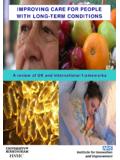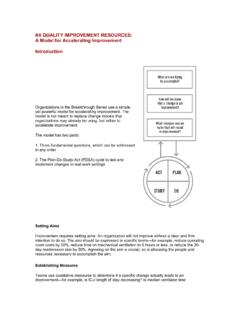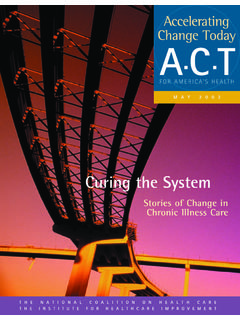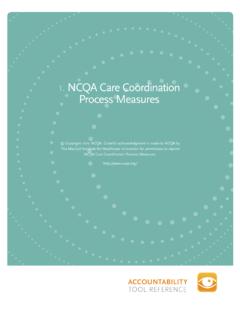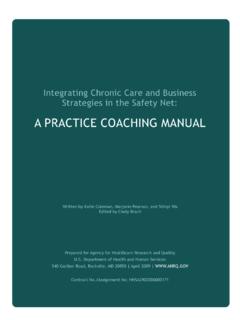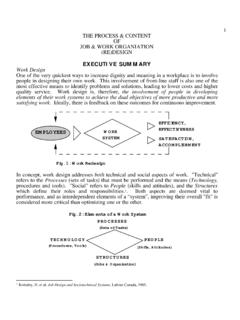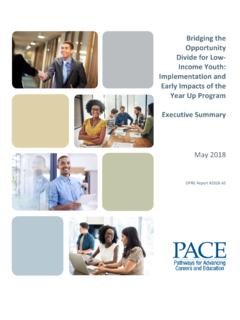Transcription of Reducing Care Fragmentation Executive Summary
1 Reducing care Fragmentation Executive Summary A TOOLKIT. FOR COORDINATING care . Reducing care Fragmentation 49. Reducing care Fragmentation : A Toolkit for Coordinating care is for clinics, practices, and health systems who want to improve care coordination by transforming the way they manage patient referrals and transitions. Providing coordinated care is an essential feature of any patient-centered medical Executive home (PCMH) but one that can be challenging to implement. The toolkit Summary was designed to make it easier. This excutive Summary briefly introduces the concepts covered in detail in the toolkit and provides an overview of its contents. AN INTRODUCTION TO care . COORDINATION AND WHY.
2 IT'S SO DIFFICULT. care coordination is the deliberate organization of patient care activities between two or more participants involved in a patient's care to facilitate the appropriate delivery of health care services. 1 In other words, all providers who work with a particular patient share important clinical information and have clear, shared expectations about their roles. Equally important, they work together to keep patients and their families informed and to ensure effective referrals and transitions take place. Across health care , fragmented systems and communication breakdowns contribute to widespread failures in care coordination that have devastating consequences for patients.
3 Several factors combine to make care coordination extremely challenging: Because accountability for the process is shared, it's not clear who is responsible for making it work well. Many primary care practices (PCPs) no longer have the personal relationships with consultants and hospitals that make communication easier. The time and effort needed to carry out effective referrals and transitions is usually not reimbursed. Most PCPs do not have adequate personnel or information infrastructure (such as electronic records) dedicated to care coordination. TOOLKIT OVERVIEW In the final section, you'll find an index of all the tools and resources recommended in the toolkit, The toolkit contains practical strategies and clinical along with copies of the tools themselves or resources to help you implement specific practice changes information about where to find them online.
4 That will make care coordination easier. THE care COORDINATION. First, two patient cases illustrate what care MODEL AT A GLANCE: coordination means and why achieving it is so Key concepts, changes, and resources important and so challenging. The care Coordination Model looks at care coordination Next, the toolkit introduces a care Coordination from the perspective of a PCMH considering the Model based on key concepts that contribute to range of providers and organizations they work with, successful referrals and care transitions. including medical specialists, community agencies, and The toolkit then describes four key changes hospital and emergency facilities. The model is based that support the model and identifies tools and on four key concepts related to patient referrals and care resources available to facilitate each change.
5 Transitions: accountability, patient support, relationships and agreements, and connectivity. These four concepts are To illustrate real-world examples of improved care general ideas that drive care coordination. coordination, the toolkit follows with five case studies from diverse settings including a small To make them more useful, the toolkit translates four family care network, a safety net public hospital, specific practice changes accompanied by supporting and a regionally integrated health system delivering activities, tools, and resources. Here is a brief Summary : care Coordination Model comprehensive care . PATIENT-CENTERED. MEDICAL HOME. Accountability Involved providers Patient Support receive the information they need when they need it High-quality Practice knows the referrals &.
6 Status of all referrals/ transitions Relationships & Agreements transitions involving its panel for providers & patients Connectivity Patients report receiving help in coordinating care Community Hospitals Medical Agencies & ERs Specialists The MacColl Institute for Healthcare Innovation, Group Health Cooperative 2010. ACCOUNTABILITY PATIENT SUPPORT. Why it's important: Why it's important: When multiple practices or clinics are involved in a Referrals and transitions challenge patients and families. patient's care , all must collaborate but one must assume They raise questions that need to be answered, generate overall responsibility for organizing the care . Establishing appointments that need to be made, and produce logistical conditions and infrastructure to assure effective referrals challenges and anxiety that need to be addressed.
7 Practices and transitions is a core responsibility of the PCMH. that dedicate staff time to meeting these patient needs are Referrals are more likely to be successful when all providers more likely to have successful referrals and transitions. understand each other's expectations and preferences . and when adequate staff and information infrastructure Key change: 3. Organize a practice team to support patients and exist to help patients and their information get where they families. need to go. Activities: Key changes: Delegate/hire and train staff to coordinate referrals 1. Decide as a primary care clinic to improve and transitions of care , and train them in patient- care coordination.
8 Centered communication, such as motivational 2. Develop a tracking system for referrals. interviewing or problem solving. Activities: Assess patient's clinical, insurance, and logistical Develop a quality improvement (QI) plan to needs. implement changes and measure progress. Identify patients with barriers to referrals/. Design the clinic's information infrastructure to transitions and help patient address them. internally track and manage referrals/transitions Provide follow-up post referral or transition. including specialist consults, hospitalizations, ER. visits, and community agency referrals. Tools and resources: Referral Coordinator Job Description In the toolkit Tools and resources: NCQA care Coordination Process Measures In the Referral Coordinator Curriculum In the toolkit toolkit Patient Referral Checklist In the toolkit care Coordination Questions from Validated Instruments In the toolkit The care Transitions ProgramSM Online at www.
9 Referral Tracking Guide In the toolkit Patient Activation Assessment Form In the toolkit The Post-Hospital Follow-Up Visit: A Physician Checklist to Reduce Readmissions Online at www. follow-up-visit-a-physician-checklist RELATIONSHIPS &. AGREEMENTS CONNECTIVITY. Why it's important: Why it's important: Referrals and transitions work best when all parties To support successful referrals and transitions, all patients, primary care providers, and consultants providers involved must have the information they need agree on the purpose and importance of the referral, to optimize care and a trustworthy way of communicating. and on the roles that each will play in providing care . An electronic referral system can help assure that As close, personal relationships between PCPs and critical information flow occurs in a timely way and can specialists or hospital staff become less common, incorporate agreed upon guidelines for referrals and PCMHs should start conversations with their key transitions.
10 These goals can also be accomplished with specialist consultants or hospitals to discuss each pencil and paper standardization of referral requests and other's preferences and expectations. consultation notes, and using fax machines or phone calls to communicate. Key change: 4. Identify, develop, and maintain relationships Key change: with key specialist groups, hospitals, and 6. Develop and implement an information community agencies. transfer system. 5. Develop agreements with these key groups, Activities: hospitals, and agencies. Use a shared electronic health record or web-based referral system, or set up another standardized Activities: information flow process. Complete internal needs assessment to identify key specialist groups and community agencies with Tools and resources: which to partner.

